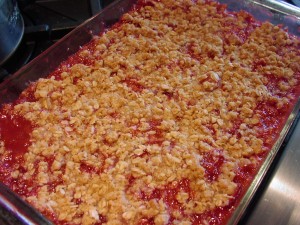I love late spring, early summer for many reasons. Two of the top reasons are fresh local strawberries and rhubarb. And in combination, I mean really, what is not to love about this dynamic duo? And then when I think of strawberries and rhubarb in a crisp, I practically start to drool just thinking about this fabulous fruit dessert. But alas dear friends, there is actually not a speck of true fruit in a Strawberry Rhubarb Crisp. Strawberries are members of the rose family. Botanists refer to them as “false fruit,” or pseudocarp. A strawberry is a multiple fruit which consists of many tiny individual fruits embedded in a fleshy receptacle. The brownish or whitish specks, which are commonly considered seeds, are the true fruits, called achenes, and each of them surrounds a tiny seed. And then, to make our beloved strawberries even more difficult to fathom, they aren’t even true berries! But eggplants, tomatoes, and avocados are! (I am so confused!) Then there’s rhubarb.
Rhubarb is a perennial that forms large fleshy rhizomes and large leaves with long, thick (and tasty) petioles (stalks). Rhubarb originated in Asia over 2,000 years ago. It was initially cultivated for medicinal purposes. It was not until the 18th century that rhubarb was grown for culinary purposes. Rhubarb is often commonly mistaken to be a fruit but rhubarb is actually a close relative of garden sorrel, and is therefore a member of the vegetable family. Rhubarb is rich in vitamin C and dietary fiber, as are strawberries. With strawberries, it’s the achenes that cause strawberries to be relatively high in fiber. According to the Wellness Encyclopedia of Food and Nutrition, “one-half cup of strawberries supplies more fiber than a slice of whole wheat bread, and more than 70 percent of the recommended daily allowance of vitamin C”.
So ladies and gentlemen, regardless of what strawberries (Frugaria) or rhubarb (Rheum) are or aren’t, they remain at the top of my list of yummy “whatevers” to eat at this time of year. And a truly great way to prepare both of these “whatevers” is this luscious crisp based on an Ina Garten recipe. Just don’t forget to top with a scoop of vanilla ice cream. (And no, I’m not even going to attempt to explain vanilla, except to say that vanilla beans are the dried fruit of the vanilla orchid which can only grow in areas where Melipona, a genus of stingless bees spend their summer vacation!)
- 1 c. flour
- 1/2 c. brown sugar
- 1 1/4 c. granulated sugar, divided
- 1/2 tsp. kosher salt (unless using salted butter)
- 1 c. rolled oats
- 12 T. cold butter, diced
- 4 c. fresh rhubarb, diced
- 4 c. fresh strawberries, hulled and cut into same size pieces as the rhubarb
- 1 1/2 tsp. grated orange zest
- 1 T. cornstarch
- 1/4 c. freshly squeezed orange juice
- vanilla ice cream, opt.
Combine the flour, 1/2 cup granulated sugar, brown sugar, salt, and oatmeal in the bowl of an electric mixer fitted with the paddle attachment. Add the butter and mix until the ingredients form large crumbles. Set aside. Toss the rhubarb, strawberries, remaining 3/4 cup of the granulated sugar, and orange zest together in a large bowl. Dissolve the cornstarch in the orange juice; mix into the fruit. Scoop into a 9×13-inch baking dish. Sprinkle the topping over the fruit and bake in a pre-heated 350 degree oven for 1 hour, or until the fruit is bubbling and the topping is a light golden brown. Allow to cool for about an hour and serve warm with vanilla ice cream.

